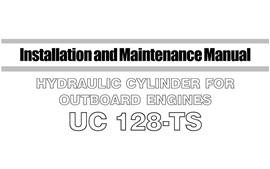
Is It Hard to Install Hydraulic Boat Steering
Published on November 01, 2019 by Andy Garcia
Is It Hard to Install Hydraulic Boat Steering
This is a great question that is asked all the time. Installing hydraulic boat steering requires the same amount of time in most cases, as when installing new mechanical boat steering. The difference is there is a couple of more steps required in the set-up, once the system components helm, hoses and steering cylinder have been installed. If you are replacing a system that is already there, then the install task involved, takes less time and is less demanding. Installing hydraulic boat steering is a three step method that you can do yourself, if you are mechanically inclined and have some basic tools at your disposal. If after reading the installation steps listed below, seems to overwhelming, then I would greatly suggest seeking a certified marine technician to handle this task.

Step 1. Before purchasing any parts or complete kits you need to do some planning. We start with general specifications with your boat to determine the correct parts that will be needed for your hydraulic boat steering kit. Start with determining how many stations and engines you have. (See above Illustration). Multiple stations requires multiple helms, and extra hoses. Like- wise with multiple engines. Multiple engines can require extra cylinders, hoses and even tie bars that are necessary based on engine make, model, year and hp ratings. After you have determined what your application needs are going to be your next step will be to do some visual inspections and takes some measurements to complete your parts list. You need to determine what helm type mounting configuration you will need. Just determine how much room you have behind the helm area (steering wheel) of where the helm or helms will be mounted. This will determine what helms you can use. Your choices will be either a front mount, rear mount and or tilt mount helm configuration. Next is to measure for hose lengths. If multiple helms then we need to measure from helm to helm and then helm back to cylinder or cylinders. If multiple helms and cylinders are going to be used you will need multiple sets of hose kits. Make sure and give yourself and extra 2-feet at the engine for single engine and additional 2-feet for multiple engine cylinders, which allows for correct fit with movement of the cylinders (engines).
Step 2. Now that you have determined all of the parts you need and have them in your hands, you can begin the install. Mounting the helm or helms will require cutting out the exact dimensions described in the helm's installation instructions. If this is a replacement helm you may need to widen the existing cut-out or if the cut-out is too large then you will have to purchase a separate mounting bezel kit to accommodate the install of the helms. Once the helms have been installed you need to install the hose kits from helm to helm if required and then helm back to engines.
Final Step 3. Install all cylinders and associated hardware as needed on to engines per the supplied installation instructions. Note: In some cases engine removal may be required. Once the cylinders are in place, connect all hose's as required and make sure that the hoses are ran in the directions described in the installation instructions. If you connect the hoses backwards to the cylinder you will experience opposite directions when turning steering wheel. But don't panic, you just need to move the connections around and re-bleed the system. If you are doing it manually you need to have another set of hands. One person filling the helm with fluids and turning the steering wheel and one person at the cylinders opening and closing the quick connect fittings bleed valves. Once you have completed all of the steps in the install instructions and double checked all fasteners, hoses and fittings for tightness, then complete your install with a final water test and you are done. You will enjoy the benefits of hydraulic boat steering in your boat for years to come.
All
of the hydraulic steering parts and kits sold here at Marinesteering will
include installation instructions for correct install per OEM specifications.
The instructions above is just for reference only and we recommend contacting
our sales staff or a local professional certified marine technician in your
area for installation.
Happy boating!

